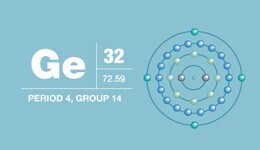Search

table of Elements
Germanium
Germanium X-ray photoelectron spectra, germanium electron configuration, and other elemental information.
Join the conversation
Germanium • Metalloid
Primary XPS region: Ge2p, Ge3d
Overlapping regions: W4f, F2s
Binding energies of common chemical states:
| Chemical state | Binding energy Ge2p3/2 | Binding energy Ge3d5/2 |
|---|---|---|
| Ge elemental | 1217.3 eV | 29.3 eV |
| GeO | 1218.0 eV | 30.9 eV |
| GeO2 | 1220.2 eV | 32.5 eV |
Experimental information
- Ge2p or Ge3d are typically used.
- Ge3d may be preferable if germanium is buried and at low concentration.
- Ge3d electrons have higher kinetic energy and therefore have a deeper sampling depth compared to the low kinetic energy Ge2p electrons.
- Ge3d may be preferable if germanium is buried and at low concentration.
Interpretation of XPS spectra
- Ge2p region has significantly split spin-orbit components (Δ=31.1eV, intensity ratio=0.478).
- Ge2p peaks have symmetric lineshape for elemental germanium and its compounds.
- Typically only the Ge2p3/2 component of the Ge2p region is fitted and quantified.
- Loss feature may be observed between spin-orbit components (1,235eV) and to higher binding energy of Ge2p1/2 component (1,265eV).


- Ge3d peak has overlapping spin-orbit components (Δ=0.58eV, intensity ratio=0.67).
- Splitting is observable for elemental germanium, but may be ignored for germanium compounds.
- Ge3d peaks have symmetric lineshape for elemental germanium and its compounds.

General comments
- Ge LMM peaks (between 300eV-600eV) overlap with many XPS peaks from other elements.

About this element
Symbol: Ge
Date of discovery: 1886
Name origin: Latin Germania
Appearance: grayish
Discoverer: Clemens Winkler
Obtained from: copper, zinc, lead
Neutrons: 41
Shell structure: 2,8,18,4
Electron configuration: [Ar]3d104s24p2
Melting point: 1211.4 K
Boiling point: 3093 K
Density[kg/m3]: 5323
Molar volume: 13.63 × 10-6 m3/mol
Oxidation state: 4
Protons/electrons: 32
Crystal structure: cubic face centered
Chemically similar to tin, germanium is an important semiconductor. Due to its small band gap, germanium is highly sensitive to infrared light and is used as detector material in infrared and Raman spectrometers. Germanium’s refraction and dispersion properties make it useful in wide-angle camera lenses and in microscope objective lenses. Silicon germanide (SiGe) is becoming an important material in high-speed integrated circuits. Germanium transistors are used in modern electric guitars to simulate the sound of Rock and Roll-era amplifiers.


